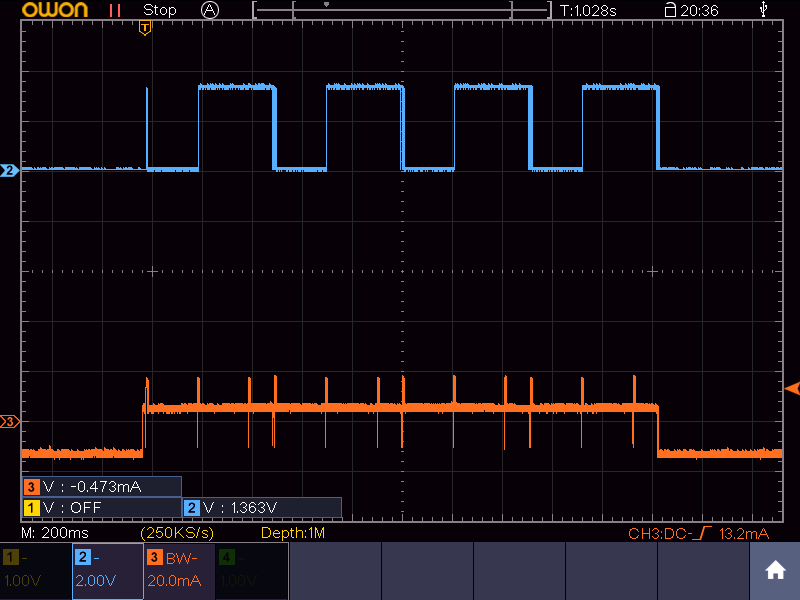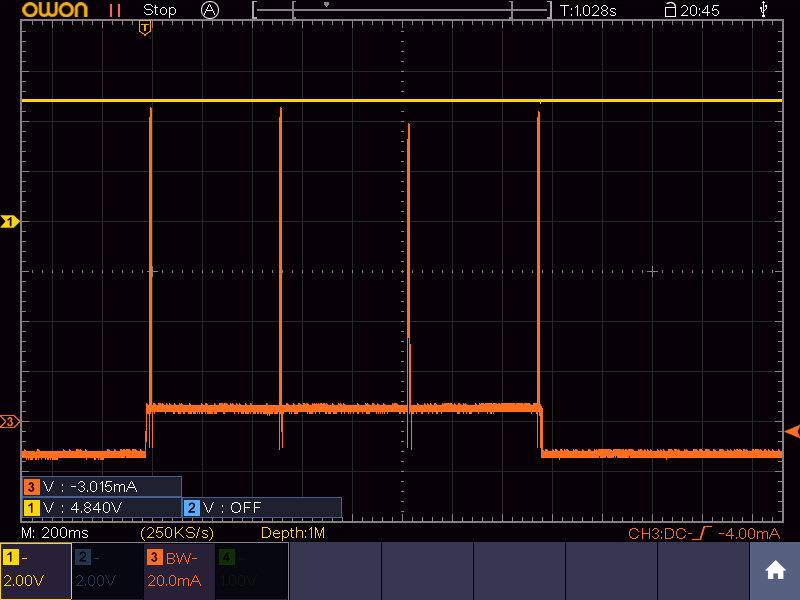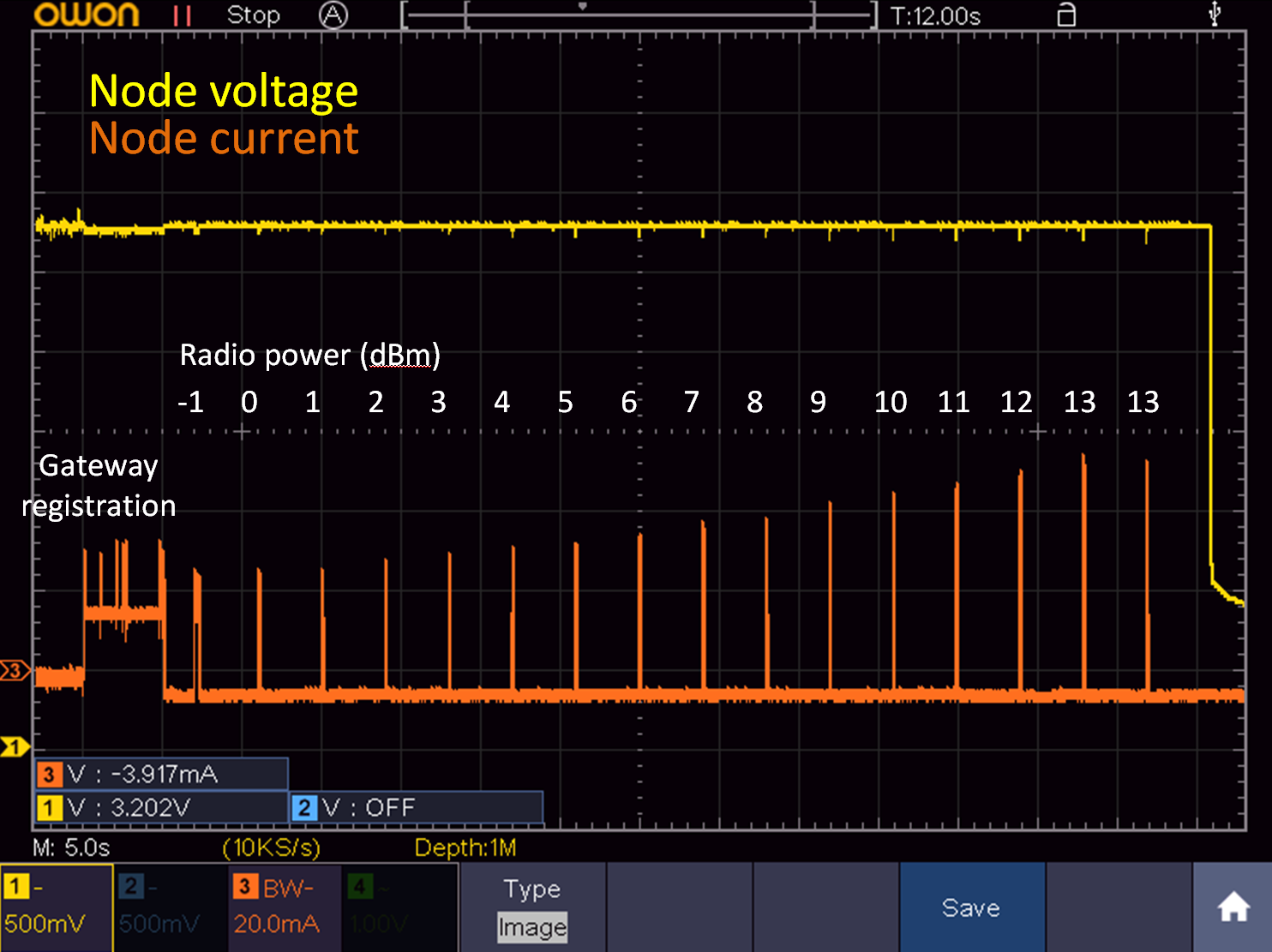RFM69 ATC not working?
-
present(1,S_SOUND);should be
present(2,S_SOUND);and you don’t need MyMessage msgTemp(1,V_TEMP);
I am not sure about the error. Are you using the rpi gw as serial, mqtt or ethernet gw? (What was your configure command?)
@mfalkvidd
I improved the power supply of the RFM (added linear regulator) on the gateway and the error is gone.The code doesn't compile if I don't declare msgTemp, as I use msgTemp in the main loop.
Where should I see the message the GW is sending? On the node? I'm using a custom node without a serial connection, so I can't see incoming messages on the node. Is there a way to have the GW send the RSSI to its own log?
-
present(1,S_SOUND);should be
present(2,S_SOUND);and you don’t need MyMessage msgTemp(1,V_TEMP);
I am not sure about the error. Are you using the rpi gw as serial, mqtt or ethernet gw? (What was your configure command?)
@mfalkvidd
I was using serial gateway by the way. -
@mfalkvidd
I improved the power supply of the RFM (added linear regulator) on the gateway and the error is gone.The code doesn't compile if I don't declare msgTemp, as I use msgTemp in the main loop.
Where should I see the message the GW is sending? On the node? I'm using a custom node without a serial connection, so I can't see incoming messages on the node. Is there a way to have the GW send the RSSI to its own log?
-
@tsd I don’t know. I've always connected the gateways to my controller where I get logs and graphs.
Maybe you can use GATEWAY_DEBUG(text)
#define GATEWAY_DEBUG(text)or
#define MY_DEBUGdoesn't show any additional messages in the log, besides the node messages.
In the mean time I installed Domoticz to try it your way, but don't see the USB port that I tried to make by installing the serial gateway (ttyUSB020, which is not in /dev yet, so should be free).
This command should take care of that, right?
./configure --my-gateway=serial --my-serial-is-pty --my-serial-pty=/dev/ttyUSB020Sorry to be such a pain, but I would really like to get this sorted out.
-
#define GATEWAY_DEBUG(text)or
#define MY_DEBUGdoesn't show any additional messages in the log, besides the node messages.
In the mean time I installed Domoticz to try it your way, but don't see the USB port that I tried to make by installing the serial gateway (ttyUSB020, which is not in /dev yet, so should be free).
This command should take care of that, right?
./configure --my-gateway=serial --my-serial-is-pty --my-serial-pty=/dev/ttyUSB020Sorry to be such a pain, but I would really like to get this sorted out.
@tsd sorry for being unclear. This is how to use GATEWAY_DEBUG:
GATEWAY_DEBUG("This message will be sent to the debug log")But I am not sure it is available in sketches and I don't have access to a computer at the moment.
The configure command looks good. After running configure, did you continue with make, etc?
-
@tsd sorry for being unclear. This is how to use GATEWAY_DEBUG:
GATEWAY_DEBUG("This message will be sent to the debug log")But I am not sure it is available in sketches and I don't have access to a computer at the moment.
The configure command looks good. After running configure, did you continue with make, etc?
@mfalkvidd
Do you mean#define MY_DEBUG_VERBOSE_GATEWAYThat uses the GATEWAY_DEBUG("text") macro that you are referring to. I tried that, but it doesn't give any additional output in the log.
Yes, this is the complete code I run:
sudo ./configure --my-transport=rfm69 --my-rfm69-frequency=868 --my-is-rfm69hw --my-gateway=serial --my-serial-is-pty --my-serial-pty=/dev/ttyUSB020 sudo make install sudo systemctl start mysgw.serviceBut ttyUSB020 doesn't appear in /dev afterwards, nor does Domoticz list it.
-
@mfalkvidd
Do you mean#define MY_DEBUG_VERBOSE_GATEWAYThat uses the GATEWAY_DEBUG("text") macro that you are referring to. I tried that, but it doesn't give any additional output in the log.
Yes, this is the complete code I run:
sudo ./configure --my-transport=rfm69 --my-rfm69-frequency=868 --my-is-rfm69hw --my-gateway=serial --my-serial-is-pty --my-serial-pty=/dev/ttyUSB020 sudo make install sudo systemctl start mysgw.serviceBut ttyUSB020 doesn't appear in /dev afterwards, nor does Domoticz list it.
@tsd I think you'll need to run make before make install.
configure prepares the settings for make
make compiles the code into an executable file called mysgw, including changes to the cpp file and the settings from the configure command
make install copies the mysgw executable to /etc/init.d/ -
If I run "make install" while the code has not compiled yet, it will compile before installing. If you first run "make" seperately, "make install" will only install.
I'm almost there. I configured an Ethernet gateway (couldn't get serial gateway to work) and can now see the temperature, receive RSSI and sending RSSI from the node in Domoticz.
The gateway receive function shows up as "S_ARDUINO_REPEATER_NODE", but there's no data yet.
What data should I pass on to your receive function? My gateway code is now as follows:
#define MY_DEBUG_VERBOSE_GATEWAY #include <MySensors.h> MyMessage msgTemp(1,V_TEMP); MyMessage msgRSSI(2,V_LEVEL); #define ARDUINO 100 // This space is intended to be used to include arduino libraries #undef ARDUINO void setup() { // Setup locally attached sensors } void presentation() { // Present locally attached sensors here present(2,S_SOUND); } void loop() { // Send locally attached sensors data here receive(msgTemp); } void receive(const MyMessage &message) { int16_t rssiReceive = RFM69_getReceivingRSSI(); if (message.sender == 1 ) { send(msgRSSI.set(rssiReceive,0)); } } -
If I run "make install" while the code has not compiled yet, it will compile before installing. If you first run "make" seperately, "make install" will only install.
I'm almost there. I configured an Ethernet gateway (couldn't get serial gateway to work) and can now see the temperature, receive RSSI and sending RSSI from the node in Domoticz.
The gateway receive function shows up as "S_ARDUINO_REPEATER_NODE", but there's no data yet.
What data should I pass on to your receive function? My gateway code is now as follows:
#define MY_DEBUG_VERBOSE_GATEWAY #include <MySensors.h> MyMessage msgTemp(1,V_TEMP); MyMessage msgRSSI(2,V_LEVEL); #define ARDUINO 100 // This space is intended to be used to include arduino libraries #undef ARDUINO void setup() { // Setup locally attached sensors } void presentation() { // Present locally attached sensors here present(2,S_SOUND); } void loop() { // Send locally attached sensors data here receive(msgTemp); } void receive(const MyMessage &message) { int16_t rssiReceive = RFM69_getReceivingRSSI(); if (message.sender == 1 ) { send(msgRSSI.set(rssiReceive,0)); } } -
This is how I monitor RSSI and power % from the node: sending RSSI should be close to the RSSI target value set in the config file. I left atc enabled and if I move the node away from the gateway I see the power % going up while RSSI value stays more or less the same.
#ifdef MY_RADIO_RFM69 rssi = RFM69_getSendingRSSI(); // read RSSI in RFM69. Measure reception signal from gw send(msgRSSI1.set(rssi)); // send RSSI level wait(500); // wait to get idle rssi = RFM69_getReceivingRSSI(); // read RSSI in RFM69. Wait and measure background noise send(msgRSSI2.set(rssi)); // send RSSI level wait(200); // wait for next send PwrPcnt = RFM69_getTxPowerPercent(); // read TX Power in RFM69 send(msgPWR.set(PwrPcnt)); // send TX Power #endif -
@mfalkvidd
My code now looks pretty much the same as yours, except for the OTA stuff. But I don't see gateway messages in Domoticz. The node shows up with all its measurements.#define MY_DEBUG_VERBOSE_GATEWAY #include <MySensors.h> MyMessage msgRSSI(1,V_LEVEL); #define ARDUINO 100 // This space is intended to be used to include arduino libraries #undef ARDUINO void setup() { // Setup locally attached sensors } void presentation() { // Present locally attached sensors here present(1,S_SOUND); } void loop() { // Send locally attached sensors data here } void receive(const MyMessage &message) { int16_t rssiReceive = RFM69_getReceivingRSSI(); if (message.sender == 1 ) { send(msgRSSI.set(rssiReceive,0)); } }Is the gateway supposed to show up as a measurement? Any idea why that doesn't happen?
-
This is how I monitor RSSI and power % from the node: sending RSSI should be close to the RSSI target value set in the config file. I left atc enabled and if I move the node away from the gateway I see the power % going up while RSSI value stays more or less the same.
#ifdef MY_RADIO_RFM69 rssi = RFM69_getSendingRSSI(); // read RSSI in RFM69. Measure reception signal from gw send(msgRSSI1.set(rssi)); // send RSSI level wait(500); // wait to get idle rssi = RFM69_getReceivingRSSI(); // read RSSI in RFM69. Wait and measure background noise send(msgRSSI2.set(rssi)); // send RSSI level wait(200); // wait for next send PwrPcnt = RFM69_getTxPowerPercent(); // read TX Power in RFM69 send(msgPWR.set(PwrPcnt)); // send TX Power #endif -
it works the same, of course if you have a HW version you will see TX power % lower compared to a W module. I am not using those functions on the gateway because they are actually more node related
@gohan @mfalkvidd
I think it is related to the Raspberry Pi implementation of MySensors. If I use an Arduino/RFM69 gateway, the RSSI is as expected. At close range, the power drops to the minimum possible level and the RSSI is strong. I noticed that the interrupt pin is toggled during communication, see picture below (orange is node current, blue is gateway interrupt).

If I use the Raspberry gateway (with origin/development-3.0.0 MySensors), I get the following result (orange is node current, yellow is gateway interrupt). The same result is obtained with MySensors 2.3.0 (origin/master). I couldn't get the origin/development version to compile. It gives an error about MY_DEBUGDEVICE.

Apart from the much higher node current (and worse RSSI), the interrupt pin is always high and not toggled.Are you guys using a Raspberry gateway, or an Arduino gateway?
I haven't had time to dig into to the MySensors code further, but does any of you know if this could be the problem?
-
@gohan @mfalkvidd
I think it is related to the Raspberry Pi implementation of MySensors. If I use an Arduino/RFM69 gateway, the RSSI is as expected. At close range, the power drops to the minimum possible level and the RSSI is strong. I noticed that the interrupt pin is toggled during communication, see picture below (orange is node current, blue is gateway interrupt).

If I use the Raspberry gateway (with origin/development-3.0.0 MySensors), I get the following result (orange is node current, yellow is gateway interrupt). The same result is obtained with MySensors 2.3.0 (origin/master). I couldn't get the origin/development version to compile. It gives an error about MY_DEBUGDEVICE.

Apart from the much higher node current (and worse RSSI), the interrupt pin is always high and not toggled.Are you guys using a Raspberry gateway, or an Arduino gateway?
I haven't had time to dig into to the MySensors code further, but does any of you know if this could be the problem?
-
@gohan
I just tried with the node on MySensors 2.2.0, but I get the same result. I cannot get the gateway to compile with 2.2.0, I get the following errors:In file included from ./MySensors.h:49:0, from examples_linux/mysgw.cpp:83: ./drivers/RFM69/new/RFM69_new.cpp: In function ‘bool RFM69_initialise(uint32_t)’: ./MyConfig.h:716:26: error: ‘DEFAULT_RFM69_IRQ_NUM’ was not declared in this scope #define MY_RFM69_IRQ_NUM DEFAULT_RFM69_IRQ_NUM ^ ./drivers/RFM69/new/RFM69_new.cpp:230:18: note: in expansion of macro ‘MY_RFM69_IRQ_NUM’ attachInterrupt(MY_RFM69_IRQ_NUM, RFM69_interruptHandler, RISING); ^~~~~~~~~~~~~~~~ In file included from ./MySensors.h:347:0, from examples_linux/mysgw.cpp:83: ./hal/transport/MyTransportRFM69.cpp: In function ‘uint8_t transportReceive(void*)’: ./hal/transport/MyTransportRFM69.cpp:80:54: error: ‘RFM69_recv’ was not declared in this scope return RFM69_recv((uint8_t*)data, MAX_MESSAGE_LENGTH); ^ In file included from ./MySensors.h:343:0, from examples_linux/mysgw.cpp:83: ./drivers/RFM69/new/RFM69_new.cpp: At global scope: ./drivers/RFM69/new/RFM69_new.cpp:749:12: warning: ‘void RFM69_encrypt(const char*)’ defined but not used [-Wunused-function] LOCAL void RFM69_encrypt(const char *key) ^~~~~~~~~~~~~ ./drivers/RFM69/new/RFM69_new.cpp:599:12: warning: ‘void RFM69_ATCmode(bool, int16_t)’ defined but not used [-Wunused-function] LOCAL void RFM69_ATCmode(const bool onOff, const int16_t targetRSSI) ^~~~~~~~~~~~~ ./drivers/RFM69/new/RFM69_new.cpp:340:15: warning: ‘uint8_t RFM69_receive(uint8_t*, uint8_t)’ defined but not used [-Wunused-function] LOCAL uint8_t RFM69_receive(uint8_t *buf, const uint8_t maxBufSize)Do you have the gateway running with 2.2.0? And ATC works for the RFM69?
-
@mfalkvidd
And if you turn on ATC? Does that work? Are you on 2.3.0? -
@mfalkvidd
And if you turn on ATC? Does that work? Are you on 2.3.0?

